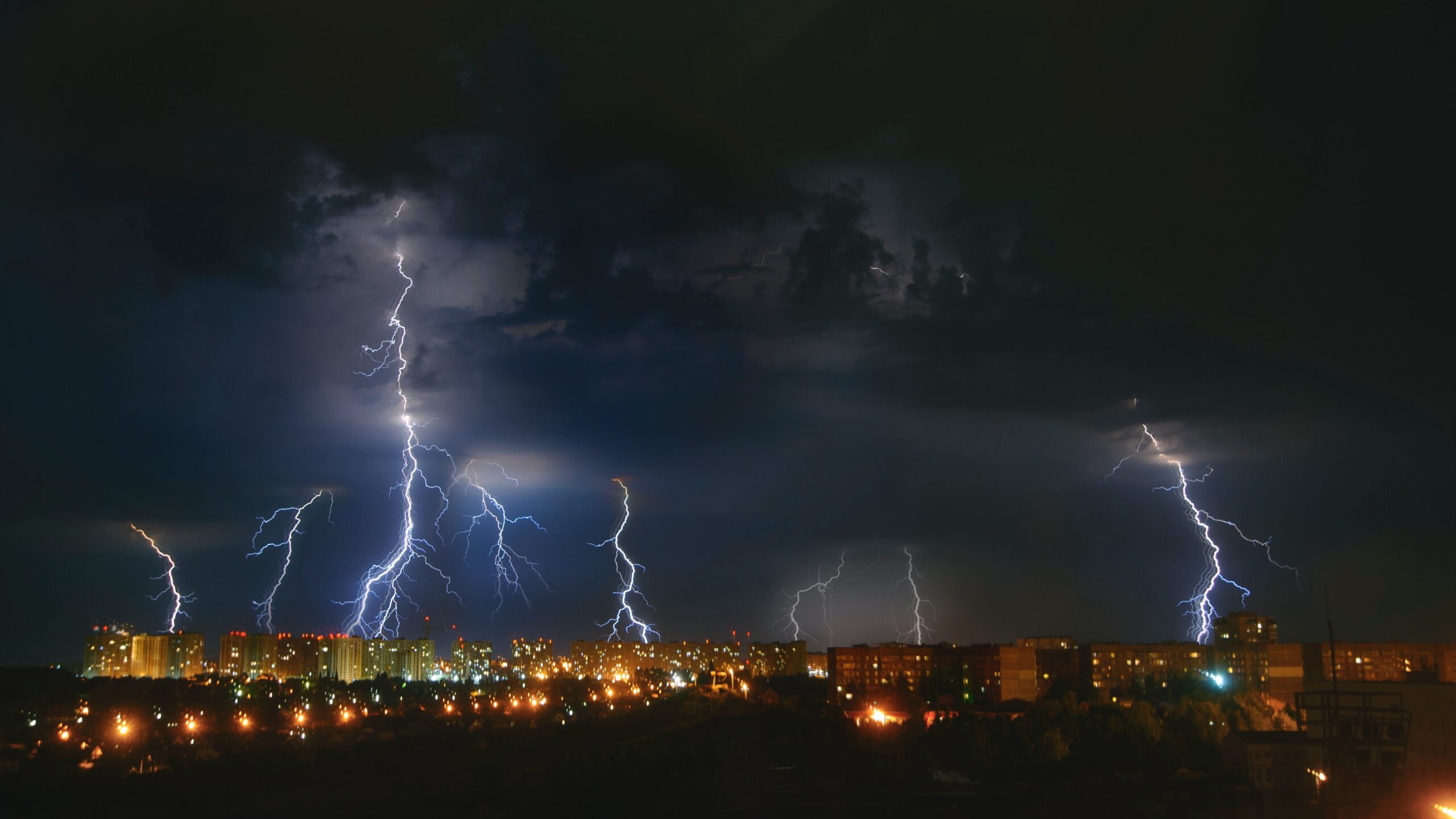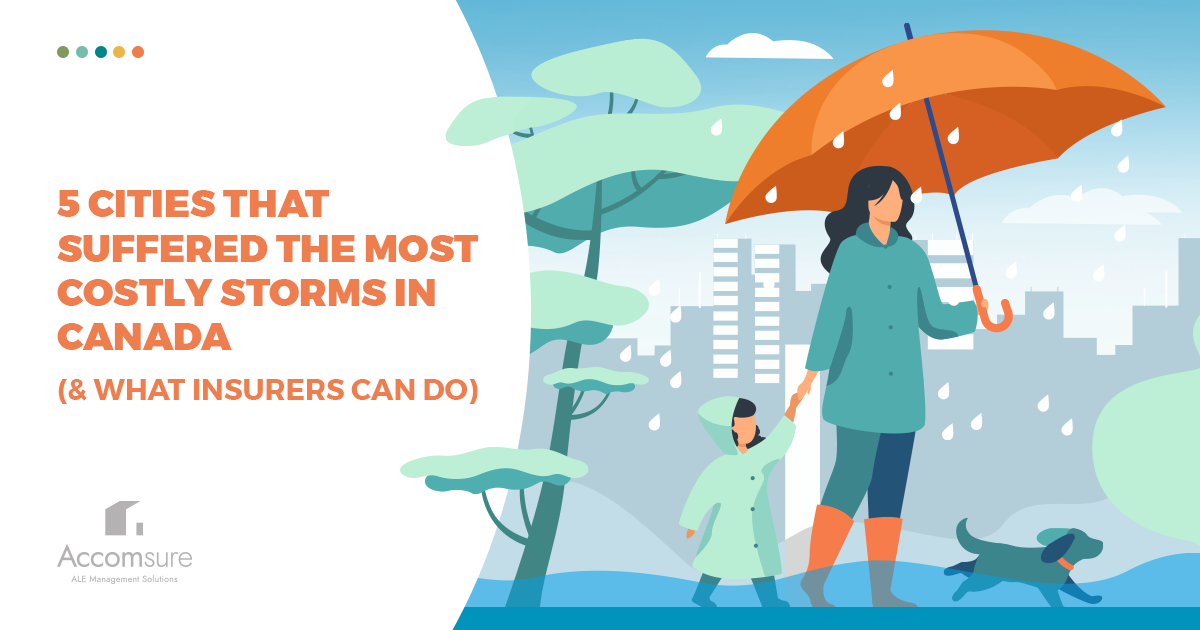Due to the climate crisis, many areas in Canada are experiencing increased storms and extreme weather events that are costing Canadian insurance companies more in insured damages each year.
2021 cost Canadian insurance companies an estimated $2.1 billion from severe weather events alone. Some of the most costly weather events include hailstorms, rainstorms, floods, and windstorms.
Below we list five Canadian cities that have experienced the most costly storms in recent years and what insurers can do to support their policyholders.
Abbotsford

In 2021, Abbotsford and a large portion of the southern BC area were hit by a massive flood estimated to be the most costly weather event in the provinces’ history. Across the province, insured damages cost approximately $450 million, not including uninsured damages. The Sumas Prairie Region in Abbotsford was hit the hardest, experiencing 540mm of rain. Apart from flooding damages, the area also had to deal with damages related to landslides.
The road to recovery for those who lost their livelihood is long and challenging. Abbotsford’s mayor quoted the recovery efforts would take two years.
Calgary
Calgary is prone to storms due to its location. The city lies between the mountains that bring high elevation winds, cold wind from the north, and humidity from the south. These three factors play into why the city continues to see turbulent weather events such as flooding and hail.
The 2013 Calgary flood cost $1.8 billion in insured damages. The heavy rain resulted in an estimated 80,000 Calgary residents needing to be evacuated, making it the worst flood in the city since 1932.
As we mentioned earlier, Calgary’s location plays a key role in how the city is affected by extreme weather. Regardless of the year, hailstorms cost Calgarians millions of dollars in insured property damages. Calgary is one area, in particular, known for severe hail. Most recently, the 2021 July hailstorm resulted in $247 million in insured damages.
However, the hailstorm that hit the city in June 2020 cost $1.2 billion in insured damages, making it the fourth costliest natural disaster in Canadian history. Tennis ball-sized hail shattered windows on cars and homes, as well as major damages to siding and roofs.
Toronto

Many cities are built along rivers, lakes or harbours, putting them at a higher risk of flooding. Toronto is no exception. The city ranks within the top ten Canadian cities that experience the most thunderstorms. With the climate crisis increasing, the severity of extreme weather, heatwaves, frigid temperatures, and intense rain will be increasingly common in the area.
Thunderstorms in Canada can quickly result in extensive insurance costs. The 2013 flood in the Greater Toronto Area remains one of the most costly extreme weather events in the province’s history. 126 mm of rain fell that day, making it the worst flood since Hurricane Hazel in 1954. The sudden heavy rainfall that flooded the region cost $1 billion in insured damages.
Toronto is also no stranger to extreme cold and freezing rain during the winter. In December 2013, an ice storm hit the city of Toronto. Over 300,000 Toronto Hydro customers were without power, and it cost roughly $12.9 million in power restoration alone. For insurance companies, the cost was much greater. Damages claims were over $150 million, making the ice storm one of the most costly the province has ever faced.
Hamilton
Like Toronto, Hamilton also falls under the top ten cities with the most frequent thunderstorms in Canada. In addition, thunderstorms also bring the risk of extreme winds.
In March 2017, a windstorm hit the Hamilton and Niagara region which caused over $100 million in damages. Windspeeds were highest in Hamilton, being recorded at 115 km/hr.
Just a year later, a similar weather event caused extensive damage. On May 4, 2018, a windstorm swept through parts of Ontario and Quebec. Over 925,000 people experienced power outages, and homes across the city suffered severe damages.
In Hamilton, wind speeds were recorded at 126 km/hr. The majority of damages came from trees falling onto homes or vehicles, leaving some unable to leave their neighbourhood. The windstorm cost over $680 million in insured damages and is the most costly weather event for the province since the 2013 Toronto flood.
Fort McMurray
Although the Fort McMurray wildfires remain the most costly natural disaster in Canada’s history, the city has also faced the repercussions of extreme storms.
In 2020, an ice jam along the Athabasca river caused downtown Fort McMurray to flood. Ice jams can cause water levels to increase rapidly. As a result, 13,000 people were forced out of their homes. The flood caused approximately $562 million in insured damages. Since then, Fort McMurray has been building a permanent flood mitigation infrastructure. The $527 million project should be completed by 2023.
How Insurers Can Offer Support
Extreme weather events across Canada are only increasing in severity and frequency. With that said, there are ways insurers can both offer and receive support to help Canadians protect their assets.
Incentivizing Policyholders
While we all have a role to play in fighting the climate crisis, incentivizing your policyholders to mitigate their risks and prevent damages to their property can help your insurance company save money in the long run.
Some home insurance companies are now offering incentives for policyholders who invest in reducing climate risks by providing discounts in premiums or financial assistance. By reducing risk, insurance companies will thus spend less on costly claims.
There are some simple ways your policyholders can help reduce the risk of property damages. With spring on the way, melting snow can cause damage to homes. Some examples you can communicate to your policyholders include:
- Clearing eavestroughs to allow melting snow to flow
- Conducting regular roof inspections to ensure there are no leaks
- Keeping snow away from foundation walls
- Using caulk for any cracks in the foundation
Insurers Working with Governments to Mitigate Storms
Governments and insurance companies are investing in diverse ways to mitigate storm severity. Examples include cloud seeding and flood mitigation efforts.
Cloud seeding is a weather-modification technique used to reduce the severity of hailstorms. When used for storm mitigation, cloud seeding helps turn larger hailstones into smaller, softer ones to prevent hail damage.
In order to reduce the damages caused by floods, insurance companies can also help governments fund flood mitigation projects. For example, after insurance companies and homeowners were faced with extreme damage costs due to the 2013 flood in Calgary, it was clear that more needed to be done to prepare and protect Calgarians. To prevent future floods from being so costly, the city of Calgary and the provincial government jointly funded a flood mitigation project. The Springbank off-stream reservoir will divert water away from the Elbow River during a flood and temporarily store it in nearby farmlands and wetlands. The proposed $432 million project is expected to be completed within the next three years.
ALE Management
Extreme weather events often cause severe damage to your policyholders’ homes resulting in the need for them to find immediate temporary accommodation. The severe storms we mentioned in this article left adjusters overwhelmed with expensive insurance claims and left many policyholders uncertain about where they would spend the night.
As an adjuster, the sudden increase in workload can lead to higher levels of stress, burnout, and negatively impact job performance. However, you don’t have to handle it all alone.
ALE management solutions allow you to focus on your policyholder’s claim. At Accomsure, we can work with your policyholders to understand their accommodation needs and help them to find temporary housing based on their claim limits. This frees up your time to do what you do best and help your policyholders return their lives back to normal as quickly as possible. Submit a claim today!




